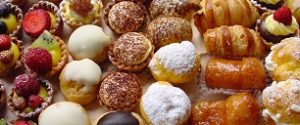Jelly Beans: Little Gems of Sweetness and Art
Jelly beans have captured the souls of candy and art enthusiasts worldwide with their myriad of flavours, colours, and associations with holidays. They are irresistibly fun to enjoy and, actually, the very first candies to be sold by weight ever! Nowadays, it’s hard to imagine a candy counter without these iconic treats.
In this blog post, we’ll embark on a delightful journey to uncover the fascinating history of these beans, tickle our taste buds with their mouth-watering flavours, take a look at creative ways people enjoy them beyond eating, and discover some interesting and fun facts about these delightful little gems.
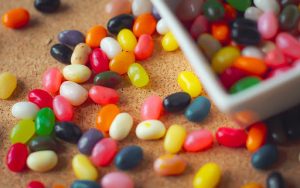
Jelly Beans in different colours & flavours
What Are They Made Of?
These chewy little tidbits are made from a number of key ingredients, including sugar, tapioca or corn syrup, and pectin or starch, plus small amounts of lecithin (an emulsifier), anti-foaming agents, beeswax, salt, and confectioner’s glaze (yep, no actual jelly).
The ingredients that give each bean a character are also added in relatively small proportions, depending on the desired taste profile, such as natural and artificial flavours and colours, chocolate, coconut, fruit puree or juice, peanuts, vanilla, oils, cream, or freeze-dried egg, milk, or fruit powders.
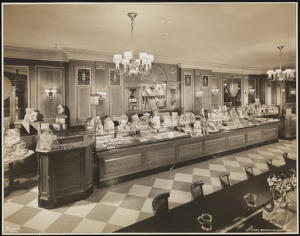
Schrafft’s candy counter at their then 2786 Broadway store in 1930 (Museum of the City of New York)
Where Did They Come From?
It is believed that jelly beans are a kind of marriage between Jordan almonds (sugar-coated almond treats) and Turkish delights (the gelly confection made from sugar and starch). Who came up with the brilliant idea of combining the two? Nobody exactly knows, but some claim that they were around by the time of the Civil War in the United States.
William Schrafft, a Boston candy maker, is credited with the earliest reference to these sweet treats. Schrafft came up with the idea to send his jelly beans to Union soldiers as a thoughtful gesture during the war, which adds a touching and nostalgic dimension to the history of these beloved candies.
The original versions were probably different in shape, but candy makers quickly embraced the charming shape of a bean. Some records show that by the 1890s, they were already being sold under that name, showcasing the early adoption of the unique form.
These sweet beans gained popularity as penny candy by the late 19th century, and their widespread appeal was enough for the term to be included in Webster’s Dictionary by 1905. By 1915, the term had even become slang (to describe a sharp-dressing man but with little substance).
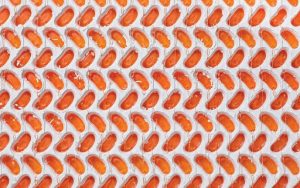
Fresh Jelly Beans on cornstarch tray (Popsci)
The Making Process
The making process was too complicated for home candy makers. The filling had to be made in a certain shape by punching bean-shaped holes into a tray of cornstarch and dropping hot starch gel into them. The hardened beans were ready for coating after a couple of days.
Creating the hard outer shell of the beans required a special piece of equipment that looks like a stainless-steel cement mixer called a “dragée pan”. The smooth candy coating of the beans is a product of colliding beans in the mixer, referred to as “panning”.
Similar to other panned sweets, jelly beans required multiple layers of candy coating. Prior to the introduction of flavoured fillings by Herman Goelitz in 1965, the filling and most of the coating were typically plain, with only the outermost layer containing flavour and colouring.
This innovative approach by Jelly Belly revolutionized the world of jelly beans, adding a burst of delicious flavour to the entire candy, from the centre to the outer coating. Today, flavoured fillings have become a hallmark, offering a wide range of taste sensations.

Colourful Beans (Saveur)
Jelly Beans Colours and Flavours: From the Classic 8 to the Wild 100+
In the beginning, the candies’ appeal was mostly in their bright colours. Traditional beans had no flavouring or colouring in the centre. The only eight original flavour options were Very Cherry, Root Beer, Cream Soda, Tangerine, Green Apple, Lemon, Licorice, and Grape. Nowadays, you can get over 100 flavours, including Mojito, Mint Chocolate Chip, Margarita, Chocolate Pudding, Gin & Tonic, Cherry Passion Fruit Smoothie, Maple Syrup, and Champagne.
According to Jelly Belly, popular jelly bean flavours vary across different regions of the world, with Very Cherry in North and South America, Lemon Lime in Asia, Bubble Gum in Australia, Tutti-frutti in Europe, and Berry Blue in the Middle East at the top of the list.
There are also preferences based on age. For instance, older generations tend to favour flavours like Buttered Popcorn, Coconut, Juicy Pear, Licorice, and Strawberry Daiquiri, while the younger generation leans toward flavours like Berry Blue, Green Apple, Raspberry, Sour Apple, and Watermelon. There are also “extreme” and themed collections with bizarre or wild flavours for those who dare to go there.

BeanBoozled Jelly Beans Spinner Game (originalcandyco)
For example, Jelly Belly’s “BeanBoozled” pairs two exactly look-alike beans that could not taste more different. You could get one of the most popular flavours or one of the wildest ones. Whether it’s Juicy Pear or Booger, Strawberry Banana Smoothie or Dead Fish, Cappuccino or Liver & Onions, there’s only one way to find out!
Why Do Jelly Beans Make Us Happy? Why Are They Addictive?
Our brain has several distinct dopamine pathways, one of which plays a major role in the motivational component of reward-motivated behaviour.
When we consume Jelly beans, we mostly consume sugar. Our brain produces a huge surge of dopamine, in a similar reaction to the ingestion of addictive substances. Researchers believe that the reaction may have roots in the fact that our body has adapted over time to look for high-calorie food to survive. With modern technology and the availability of high-calorie foods, this is no longer crucial for our survival. But our brain’s evolution has not caught up with the fact yet.
Another aspect is the aesthetics of these little beans. Their colourfulness and smooth texture glide into our throats with intense pleasure. This can turn a grey day into a sunny day.
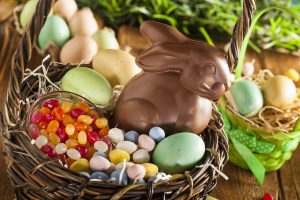
From Christmas to Easter, Reagan, and the Beatles
Jelly beans were primarily enjoyed during Christmas time. Their association with Christmas still persists, as it remains among the most popular times of the year to indulge in these delightful candies.
It wasn’t until the 1930s that their resemblance to eggs was noticed, leading to their inclusion in Easter baskets. Their association with Easter can be attributed to their shape, colour, and sweetness. They are shaped like an egg, and the colour mimics the brightly decorated traditional eggs.
Apart from the traditional associations, nowadays we have the National Jelly Bean Day (which occurs on April 22nd), a celebration of the vibrant rainbow of flavours that they offer. The day is a reminder of the joy that these tiny candies bring to our hearts, and how our lives would be incomplete without them. But these beans have made a name for themselves in politics and music as well.
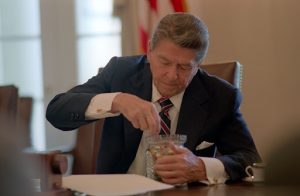
Ronald Reagan eating jelly beans (Wikimedia)
It’s widely known that Ronald Reagan, former president of the United States, had a deep fondness for jelly beans. The presidential jet had a special cup holder for his stash. He even sent them on the Challenger space shuttle in the 1980s. Interestingly, it’s said that Reagan’s love for them may have led to the invention of the blueberry flavour.
For his inauguration, the Goelitz company (known as Jelly Belly today) wanted to create a special red, white, and blue collection which prompted them to create the blueberry flavour specifically for the occasion. (Here’s a list of all US presidents and their favourite desserts for those curious).
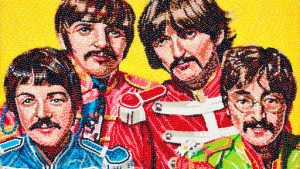
The Beatles as jelly beans art (Today)
But the Beatles’ story with these little candies was a little different. American fans of the British rock band, having read that their favourite rockers liked Jelly Babies (a type of soft gummy candy), lovingly pelted their idols with hard-shell jelly beans, under the impression that they were the same thing, which they are not!
Thinking Outside the Candy Jar: Creative Ways to Enjoy Jelly Beans!
Both you and your kids may be fans of their bright colours and delicious flavours. But did you know that people have actually gone creative and created even cooler experiences beyond eating them?
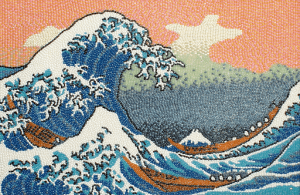
The Great Wave off Kanagawa, Kristen Cumings, 4′ x 6′ (Jelly Belly)
Jelly Belly, which is a prominent manufacturer of candies, has a private collection of large-scale portraits of famous personalities and classic subjects, all made in mosaics of thousands of jelly beans.
The collection includes portraits of Elvis Presley, Abraham Lincoln, Van Gogh’s “The Starry Night”, Ronald Reagan, Amelia Earhart, Laurel & Hardy, James Dean, a Native American chief, Pope John Paul II, Martin Luther King Jr., the Statue of Liberty, Marilyn Monroe, Asian “good luck” Dragon and many others.
The company also holds the 2010 Guinness World Record for the Largest Candy Art with a 39-foot art piece made in China, using approximately 617,000 Jelly Belly beans, created for the World Expo.
In addition to jelly beans art, people have also used the little gems to set records in other creative ways. The fastest time to eat 10 beans without using hands, most jelly beans held in one hand, and most candies thrown and caught in mouth in 40 seconds are among fun records that showcase the playful spirit of enthusiasts.
Jelly beans have captivated the hearts of candy enthusiasts worldwide with their diverse flavours, and vibrant colours and continue to hold a special place in the history of confectionery and pop culture as an iconic treat.



